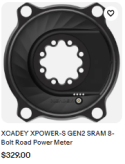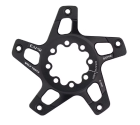Cruzbike recently ordered a quantity of high quality short cranks made by Croder Cycling in Taiwan. These are now listed for sale on our website.
We have been looking for high quality lightweight 145mm cranks for many years, and then came across these cranks at the big bicycle show in Taipei, Taiwan earlier this year.
Why are short cranks better?
This blog gives nine reasons. If you haven't already read it, please do so.
What type of interface is the crankset compatible with?
The SRAM 8-bolt standard. Any chainring, power meter, or spider compatible with this standard will fit.
Below are three example photos of the SRAM 8-bolt interface.



Why didn't you put 145 mm cranks on stock bikes before this?
Because quality ones were not available.
Will all Cruzbike models come with 145mm cranks in the future?
Yes, to the extent that we can source them. There are bicycles already in production with longer cranks, but we will make every effort to source future models with the 145mm cranks.
Can you put a double (2x) chain ring on these cranks?
Yes. 1x or 2x is fine. install your chainring(s) of choice on your (compatible) spider of choice.
Can I order directly from Croder?
Sure. Check out their cranks and accessories on their website.
How will these cranks affect my bicycle's fit?
That depends on the length of your old cranks. If they are 165mm, for example, then you may need to extend the boom out 20 mm to keep the same x-seam (165mm - 145mm = 20mm). In practice, some people don't even notice the difference and make no adjustments.
Will these work on my old Cruzbike?
Yes. All models of Cruzbike except the V20c use a BSA bottom bracket. If you have a V20c, then order a set with the T47 BB. If you have anything else, order it with the BSA BB.
Are they hard to install?
It's probably best to have your local bike shop do it, but if you have the proper tools, it is not that hard. We will be putting out an instructional video soon to assist you or your local mechanic with the installation.
We have been looking for high quality lightweight 145mm cranks for many years, and then came across these cranks at the big bicycle show in Taipei, Taiwan earlier this year.
Why are short cranks better?
This blog gives nine reasons. If you haven't already read it, please do so.
What type of interface is the crankset compatible with?
The SRAM 8-bolt standard. Any chainring, power meter, or spider compatible with this standard will fit.
Below are three example photos of the SRAM 8-bolt interface.



Why didn't you put 145 mm cranks on stock bikes before this?
Because quality ones were not available.
Will all Cruzbike models come with 145mm cranks in the future?
Yes, to the extent that we can source them. There are bicycles already in production with longer cranks, but we will make every effort to source future models with the 145mm cranks.
Can you put a double (2x) chain ring on these cranks?
Yes. 1x or 2x is fine. install your chainring(s) of choice on your (compatible) spider of choice.
Can I order directly from Croder?
Sure. Check out their cranks and accessories on their website.
How will these cranks affect my bicycle's fit?
That depends on the length of your old cranks. If they are 165mm, for example, then you may need to extend the boom out 20 mm to keep the same x-seam (165mm - 145mm = 20mm). In practice, some people don't even notice the difference and make no adjustments.
Will these work on my old Cruzbike?
Yes. All models of Cruzbike except the V20c use a BSA bottom bracket. If you have a V20c, then order a set with the T47 BB. If you have anything else, order it with the BSA BB.
Are they hard to install?
It's probably best to have your local bike shop do it, but if you have the proper tools, it is not that hard. We will be putting out an instructional video soon to assist you or your local mechanic with the installation.
Last edited:





